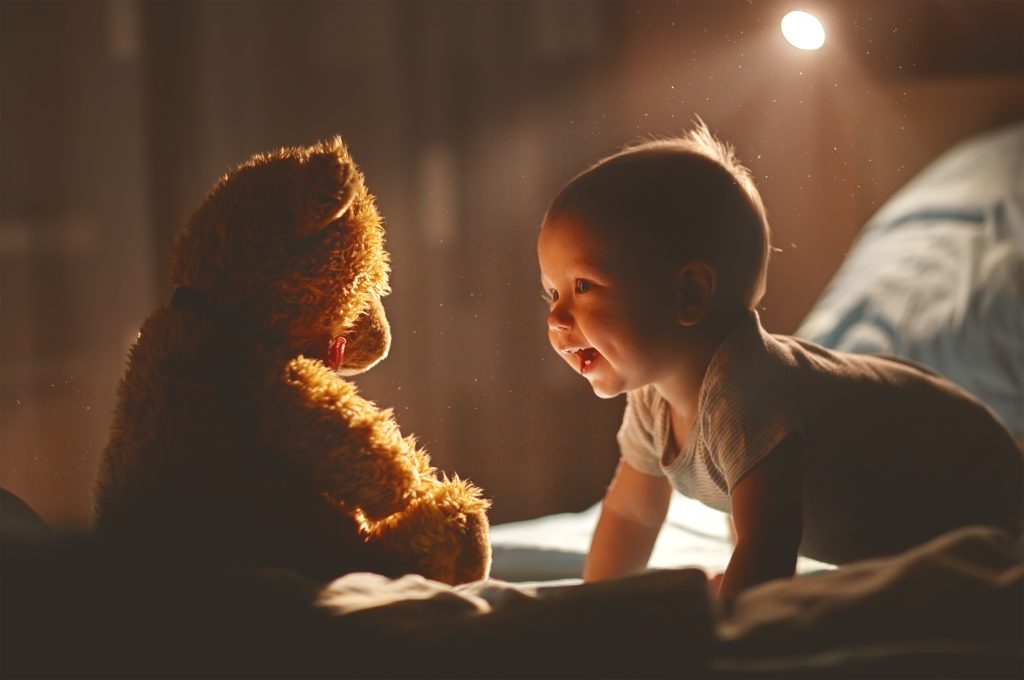Exposure to different wavelengths has been shown to affect your baby’s sleep.
When it comes to sleep, there are so many factors that might be impeding your little one’s ability to just lay their head down and go to sleep when they’re tired.
Hormone levels may be out of balance, they may be in some kind of physical discomfort, too hot or too cold, they may be overtired or not tired enough, the possibilities can seem endless.
As a child sleep expert, I can tell you that one of the most prominent causes of fractured sleep for our little ones is light.
Exposure to blue light has been shown to decrease baby’s feelings of drowsiness, increase the time it takes for them to fall asleep, decrease deep sleep, and affect their ability to stay asleep.
Light is obviously everywhere, and has been since day one.
Our ancestors were better suited to hunting and gathering during daylight hours while the light was bright enough for our eyes to pick up movement and colours. We needed rest as well, so better to sleep in the night when we wouldn’t be as efficient and at a disadvantage to predators whose eyesight was more acute in the darkness.
Over time, our bodies began secreting hormones to help us sleep when it began to get dark (melatonin) and to provide stimulation when it got light (cortisol).
This all worked pretty beautifully right up until a technological breakthrough. In 1879, everything changed. The world was introduced to the electric light bulb. Before long, we had access to light at all hours and in every room of the house.
“Wait,” you may be thinking. “What about candles? People didn’t live in the dark until light bulbs were invented!”.
You are absolutely right. The big difference between fire light and the light from electric light bulbs is the wavelength.
Without going into too much detail (you can get the science-y stuff straight from NASA if you’re interested), visible light comes in different wavelengths.
Longer wavelengths appear red or yellow. Shorter wavelengths appear white or blue.

As the light bulb became more accessible, and as the filaments evolved, we started swapping out the long wavelength red or yellow light from candles for the short wavelength blue light from electric bulbs.
Why do wavelengths matter?
To take it back to our ancestors again, the light we get from the sun during the day comes directly down through the atmosphere. That means it’s not being refracted, which results in short wavelength or “blue” light. So when your little one asks you why the sky is blue, that’s actually a big part of the answer.
When the sun starts to set, it refracts off the atmosphere which stretches out the wavelength, creating red light. Again, a big part of the reason the sky turns red during a sunset.
Our bodies and brains evolved to recognise these cues from the sun. We started secreting those hormones at the appropriate time of day. To either help us wake up and get going, or to settle down and go to sleep.
Once we brought blue light into the house, you can see how our brains started to get confused.
Our eyes started picking up “daytime” light well into the night. Our brains kept secreting cortisol to keep us alert. We started blocking the release of melatonin. Sleep suddenly found itself fighting an uphill battle.
Fast forward roughly a hundred years. We see the invention of the television, which emits a ton of blue light. Not long afterwards, computer monitors, LEDs, smart phones, and tablets came along. All having a huge impact on sleep.
Do different wavelengths improve your baby’s sleep?
To a large degree, the jury is still out on this debate. Some studies suggest that short-wavelength red light can indeed help stimulate melatonin production. Others have shown that exposure to red light, while much less inhibitive to sleep than blue light, resulted in similar or slightly less melatonin production than if baby just slept in the dark.
In essence, a red light in the nursery isn’t likely to help improve your little one’s sleep. Dark is best. However, if you need a light in the nursery for nappy changes or nighttime feedings, red light is absolutely the way to go.
Some other light management tips that will help your baby sleep better in the night include:
● Turn the lights in the house down (or if it’s summer, pull the blinds down around half way) around 1-2 hours before baby’s bedtime. Having warm lamps on instead of overhead lights is a great idea
● Reduce the use of tablets, phones, and other electronic devices around an hour before bed. Particularly avoid your little one using electronic devices in the lead up to bedtime
● Put a piece of tape or blue tac over any lights emitted by devices in your baby’s nursery
● Use a warm light (i.e. a reading lamp) during baby’s bedtime routine activities in their room.
In closing and to clarify, I am not against technology. I love the convenience that my phone provides and I love watching Netflix. I think that, properly managed, tablets provide a great source of free entertainment and educational opportunities for children. I’m not trying to suggest that you should throw every blue light-emitting device in the bin and go back to candlelight in the house.
As long as you know the facts about how wavelengths can affect your baby’s sleep, it should prove relatively easy to make a few modifications. Anything to help bring on a long night of sweet, restorative sleep for your whole family right?!
To discuss how I can assist your family to achieve good sleep, please feel free to contact me.



